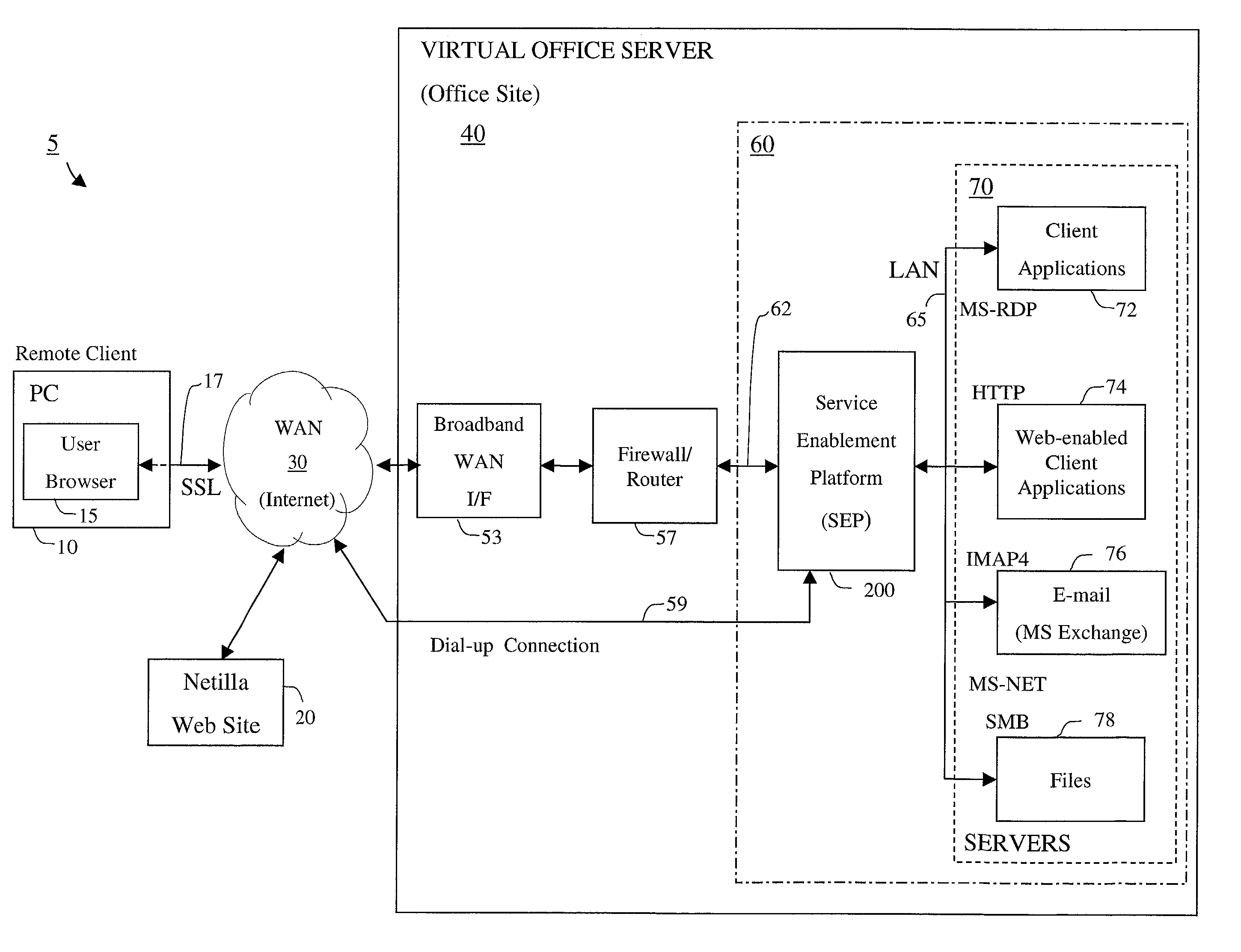However, they are all deficient in one respect or another.
In that regard, none of these approaches offers an effective, integrated solution that readily provides all the functionality obtainable using an office network through one simple remote
user interface, such as a
web browser.
Consequently, over time, this approach, particularly in view of the on-going support costs of the installed application programs, can become quite expensive.
Historically, a VPN connection required special, expensive VPN termination equipment located at each end of the connection, or required special
client software to be installed and configured at the
client machine.
This equipment was rather expensive to acquire, and proved to be rather tedious to properly configure and hence costly to administer and maintain, particularly for those small to medium sized organizations that lacked adequate in-house
technical support personnel.
However, such a terminator, which included special-purpose
software, was generally quite expensive to procure and needed to be installed and properly configured for its particular client PC—the latter entailing significant costs in both time and money.
However, PC O / S-based or client
software based VPN support requires considerable
packet processing (e.g., for packet encapsulation and disassembly, and cryptographic
processing), which disadvantageously imposes a significant
processing burden on the PC—though this burden may be acceptable for a home PC with a relatively light
processing load, rather than a remote PC connected to an office network.
Unfortunately, until rather recently such PC O / S-based VPN support used a rather small
key size, such as 40-bits, which generally does not provide sufficient security against third-party intrusion.
), this support still presents a considerable processing load to the PC; hence, denigrating PC performance, specifically processing
throughput.
Moreover, such PC operating systems, whether those exhibiting increased VPN security or not, still do not provide requisite reliability.
Not only is expensive, specialized VPN equipment required at the client site (or alternatives such as OS-based VPN support or client software packages, both with their accompanying problems, need to be used), but it is also necessary, to an even greater extent, at the LAN (central) site.
Office-site routers are considerably more expensive than client-site VPN routers for the simple reason that the processing circuitry in the former, which implements the necessary cryptographic and
packet processing operations, is sized based on a number of users that need to be simultaneously supported.
Even if such a
router is sized to support just a few simultaneous remote users on the LAN, its cost can easily amount to several thousands of dollars, with the cost rapidly escalating as user load and hence necessary processing capacity of the VPN
router increased.
Recently,
server operating systems, such as the MICROSOFT® WINDOWS® 2000 server O / S, have become available that incorporate multi-user VPN support with sufficient security features; however, such support drains considerable processing resources from the server and still is insufficiently reliable.
Moreover, if such a server O / S-based approach is used, counterpart client-site software, such as the Windows 2000 O / S, must be installed and properly configured on each client PC, which, if a large number of remote users exists, can be rather expensive and
time consuming.
Therefore, in view of the relatively high cost involved, most small to medium sized organizations were and continue to be unable to afford the use of VPN
connectivity, thus precluding themselves from providing secure remote office access to their internal networks and various business efficiencies and productivity increases that could have gained thereby.
Again, WTS, like the Metaframe program, still carries a considerable processing burden.
Unfortunately, with this ASP-based approach, the client PC did not appear as if it were connected to the LAN.
As such, while this approach did allow remote application execution, it did not accommodate remote access of other essential office network-based functionality, such as
file sharing and e-mail.
However, this approach not only proved to be rather inconvenient to use but also, due to its VPN
connectivity and for the reasons set forth above, rather expensive.
Unfortunately, this approach, being hampered by the constraints of the Metaframe software or WTS, only accommodated thin-client applications through the browser, and hence was just as “one sided”.
No other network functionality, such as e-mail or shared file access, was accommodated through the browser; hence, this approach proved somewhat inconvenient to use.
Moreover, the high cost of the associated VPN client-site and office-site servers principally dissuaded many small to medium size organizations from using this approach.
While this scheme relieved some of the load on the server, it still suffered the same deficiency as an ASP approach: it was not integrated and thus failed to provide through one single
user interface, such as a browser, all the functionality which that user would have if his(her) client PC were directly connected to his(her) office LAN.
While each RDP message from a network server to a remote client is sufficiently encrypted by WTS to preclude its brute-force
cryptanalysis, shared symmetric keys are vulnerable to
third party discovery for the simple reason that the secret key has to be distributed to the parties using it, and thus can be obtained by a malicious party.
Since the Windows 2000 WTS approach does not involve the use of certificates, it is vulnerable to “man-in-the-middle” attacks from malicious parties that have obtained the symmetric key.
That party could readily decrypt each message it received from one end and then alter the message contents as it saw fit, and transmit a modified message to the other end, thus potentially causing considerable mischief.
Since WTS provides no effective protection to so-called “man in the middle” attacks, inasmuch as its symmetric key scheme does not involve the use of certificates and public keys
cryptography, use of WTS under the WIN 2000 O / S is still not viewed by many organizations as offering a sufficiently attractive or secure solution to properly support such centralized thin-client application program hosting.
 Login to View More
Login to View More  Login to View More
Login to View More 


